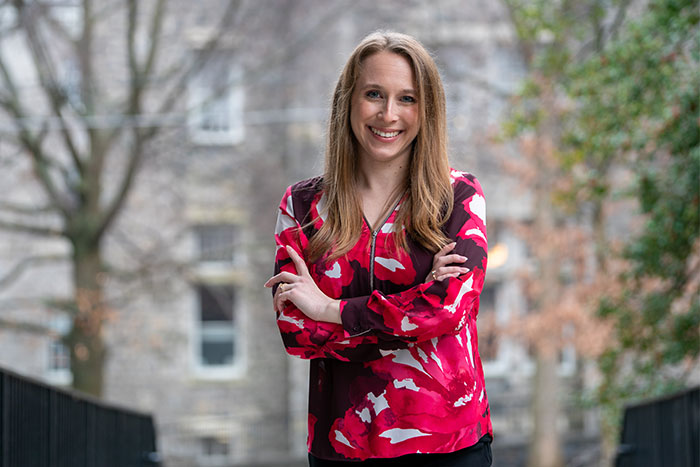10 Questions With Emily Marshall

Photo by Dan Loh.
Go beyond the numbers with the associate professor of economics and data analytics, co-chair of the Department of Data Analytics and newly named director of quantitative initiatives
by Tony Moore
1. You’re Dickinson’s first director of quantitative initiatives. What does this encompass?
Dickinson has recently started several new academic programs—including quantitative economics and data analytics—to continue our innovative and useful education while acknowledging the increased relevance of and demand for quantitative skills. We see the interdisciplinary connections consistent with our liberal-arts mission and paths for collaboration across a multitude of postgraduate experiences as an opportunity to become a leader in these fields. This position was created to continue building on the synergies and partnerships formed across campus in academic departments, administrative units and other offices related to quantitative methodologies and topics.
2. As a professor of economics, what led you into data analytics?
Data analytics is a pervasive field with tools and methodologies that span many disciplines—and economics is one of those. My dissertation was primarily in theoretical (mathematical) modeling, but I had strong training in econometrics, which examines empirical evidence using statistical methods to study economic relationships. In my first few years at Dickinson, so many students were interested in working with data, I transitioned my research agenda to incorporate empirical projects. So, it was a natural progression for me to be deeply involved in the data-science initiative and data-analytics major.
3. What makes data analytics such a vital major for Dickinson to offer?
The prevalence, quantity and availability of data are constantly increasing in both volume and complexity and are at the center of today’s greatest experiences and challenges. Academic disciplines, business models, public-health plans, ideas of social justice, community programs and governmental operations have evolved and transformed to seize the opportunities of data-driven environments. Data analytics will position our students to be critical consumers, users, explorers and communicators of data.
4. Your areas of key academic interest are the fields of monetary economics and macroeconomics. What grabs you about these?
Some people may hear “economics” and think “boring”—but, right now especially, macroeconomics affects aspects of everyone’s lives on a daily basis. In the last few years, the relevance and significance of macroeconomics has been at the forefront of the news cycle, encompassing business, financial and individual decision-making.
5. And where do you see them intersecting?
They overlap everywhere! Interest rates and the cost of borrowing, federal government debt and fiscal stimulus, housing-demand preference shifts, including deurbanization, low real-estate supply, pandemic-induced recessions, disrupted supply chains, historically low unemployment, labor shortages, determinants of oil prices, the macroeconomics of infectious diseases … I could go on!
6. You wrote an article discussing if economics is STEM? What was the verdict?
The answer is—it depends! Economics has many subdisciplines, many of which use rigorous quantitative and empirical methods that warrant classification as STEM. So a subset of economics degrees, identified as econometrics and quantitative economics, is considered STEM. The number of institutions conferring econometrics and quantitative economics degrees has increased recently from 1% of all undergraduate economics degrees conferred in 2012 to 22% in 2019. Dickinson has both a quantitative (STEM) economics major and a traditional economics degree.
7. I see you were a visiting scholar at the International Monetary Fund. What did you learn there that might be a surprise to people not paying close attention to the organization’s workings?
The division of the IMF that I worked for was the Institute for Capacity Development. It might surprise some people that this branch of the IMF has responsibilities that include teaching and educating countries’ government institutions on economic concepts and policy issues. So, in a lot of ways, there are a lot of similarities with academia—just different audiences. The training provided by the ICD is a critical component of the IMF’s work to help countries’ economies grow.
8. What made you want to become an economics professor instead of, say, an economist at BlackRock?
I was always drawn to teaching, but during graduate school I pursued other ways to use my economics education. I did find my brief experiences working with government data and in the private sector rewarding, but in very different ways than teaching. My undergraduate education was at a liberal-arts institution, and ultimately I knew that is where I wanted to build my career. Teaching, and learning from, diverse, passionate and dedicated students is one of the most fulfilling professions I can imagine. I highly value the intellectual balance between teaching and research and appreciate being part of a thriving academic community.
9. Where do you see Dickinson’s data-analytics program in 10 years?
We hope to expand our course offerings and cocurricular experiences to reach all parts of the campus, community and beyond. There are so many opportunities for collaboration, and we want to take full advantage of these experiences and partnerships, including with our alumni working in the field.
10. You’re busier than ever with economics and data analytics, so what are you up to when you’re not busy with those things?
If you had asked me before March 17, I would have proudly said watching University of Kentucky basketball! In the fall, I transition to Philadelphia Eagles football (and, of course, Kentucky is my college team). I also enjoy hanging out with my dog, Paisley.
Read more from the spring 2022 issue of Dickinson Magazine.
TAKE THE NEXT STEPS
Published May 19, 2022